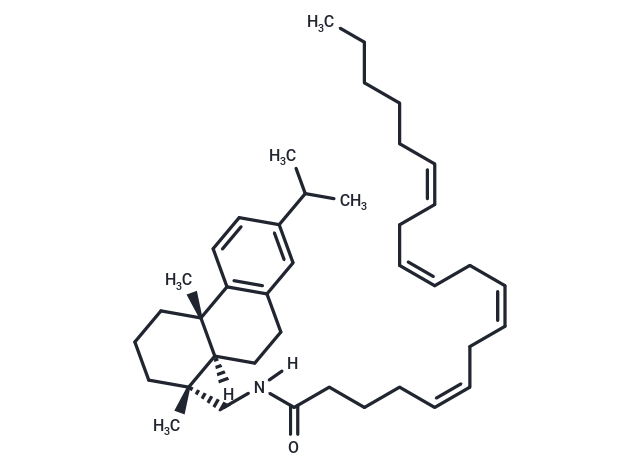Powder: -20°C for 3 years | In solvent: -80°C for 1 year


Arachidonic acid leelamide is a phospholipase A2 inhibitor. Phospholipase A is a hydrolase responsible for the release of arachidonic acid from the sn2 position of phospholipids. The released arachidonic acid is then converted to mediators of inflammation by the enzymes prostaglandin synthetase and 5lipoxygenase, respectively. The inhibition of phospholipase A leads to a decrease in the release of arachidonic acid and, consequently, the inflammatory mediators.

| Pack Size | Availability | Price/USD | Quantity |
|---|---|---|---|
| 1 mg | Inquiry | Inquiry | |
| 100 mg | Inquiry | Inquiry | |
| 500 mg | Inquiry | Inquiry |
| Description | Arachidonic acid leelamide is a phospholipase A2 inhibitor. Phospholipase A is a hydrolase responsible for the release of arachidonic acid from the sn2 position of phospholipids. The released arachidonic acid is then converted to mediators of inflammation by the enzymes prostaglandin synthetase and 5lipoxygenase, respectively. The inhibition of phospholipase A leads to a decrease in the release of arachidonic acid and, consequently, the inflammatory mediators. |
| In vitro | Arachidonic acid leelamide is the arachidonic amide analog of leelamine with no published pharmacological properties. For leelamine, it was found that electron micrographs of leelamine-treated cancer cells had an accumulation of autophagosomes, membrane whorls, and lipofuscin-like structures. In addition, leelamine-mediated killing was a caspase-independent event triggered by cholesterol accumulation in the early process [1]. |
| In vivo | In a previous study, authors identified the inductive effect of leelamine on CYP2B at doses of 5, 10, or 20 mg/kg in male ICR mice for 1 or 3 days. It was found that in the liver, the activity of CYP2B significantly increased 3.6-fold after leelamine treatment. Activities of benzyloxyresorufin O-dealkylase and pentoxyresorufin O-dealkylase significantly increased 6.3- and 5.3-fold, respectively, with a single treatment of 20 mg/kg leelamine. Moreover, immunoblot analyses showed that significantly and dose-dependently increased CYP2B10 protein levels in the liver. However, PCR results demonstrated that there were no significant changes in the CAR and CYP2B mRNA levels after leelamine treatment [2]. |
| Molecular Weight | 571.9 |
| Formula | C40H61NO |
| CAS No. | T22581 |
Powder: -20°C for 3 years | In solvent: -80°C for 1 year
DMSO: ≤20mg/ml
You can also refer to dose conversion for different animals. More
bottom
Please see Inhibitor Handling Instructions for more frequently ask questions. Topics include: how to prepare stock solutions, how to store products, and cautions on cell-based assays & animal experiments, etc.
Arachidonic Acid Leelamide T22581 Others inhibitor inhibit
